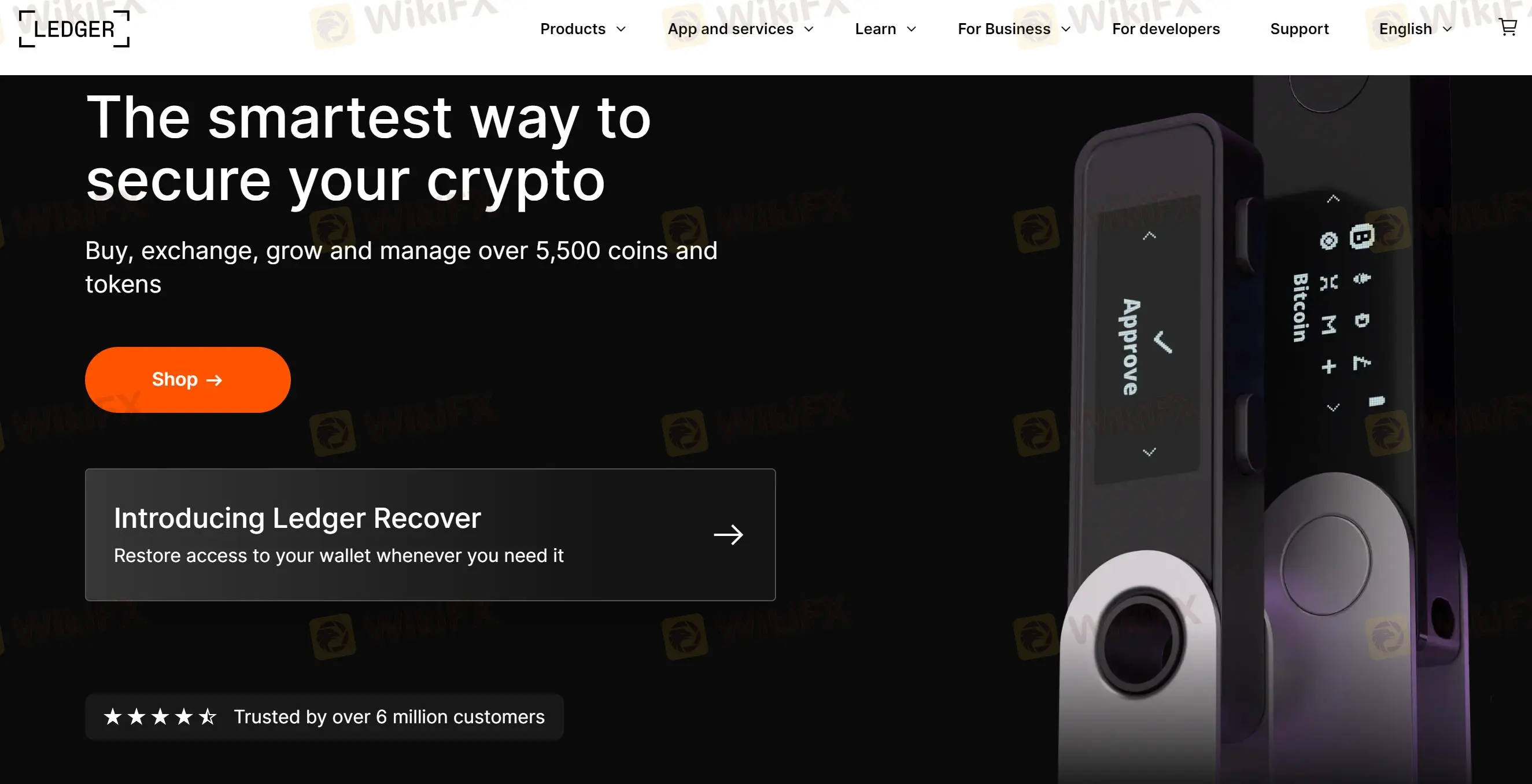简体中文
繁體中文
English
Pусский
日本語
ภาษาไทย
Tiếng Việt
Bahasa Indonesia
Español
हिन्दी
Filippiiniläinen
Français
Deutsch
Português
Türkçe
한국어
العربية
Is Ledger wallet Safe?
Abstract:Ledger is a pioneering company in cryptocurrency hardware wallets, founded in 2014 by Eric Larchevêque, Nicolas Bacca, and Joel Pobeda. Their flagship product, the Ledger Nano S, was introduced in 2016 and quickly gained popularity among crypto enthusiasts and investors for its robust security features and user-friendly interface. Designed as a cold storage solution, Ledger wallets keep users' private keys isolated from the internet, protecting them from online threats and unauthorized access. These wallets support a wide range of cryptocurrencies, allowing users to securely store, manage, and transact with various digital assets. With features like seed phrase recovery, PIN code protection, and a secure chip resistant to physical attacks, Ledger wallets prioritize the safety and convenience of managing cryptocurrencies, making them a trusted choice in the crypto hardware wallet market.
What is a Ledger wallet?
Ledger is a pioneering company in cryptocurrency hardware wallets, founded in 2014 by Eric Larchevêque, Nicolas Bacca, and Joel Pobeda. Their flagship product, the Ledger Nano S, was introduced in 2016 and quickly gained popularity among crypto enthusiasts and investors for its robust security features and user-friendly interface. Designed as a cold storage solution, Ledger wallets keep users' private keys isolated from the internet, protecting them from online threats and unauthorized access. These wallets support a wide range of cryptocurrencies, allowing users to securely store, manage, and transact with various digital assets. With features like seed phrase recovery, PIN code protection, and a secure chip resistant to physical attacks, Ledger wallets prioritize the safety and convenience of managing cryptocurrencies, making them a trusted choice in the crypto hardware wallet market.

Types of Ledger Wallet
Ledger Nano S:
The Ledger Nano S is the company's original and most affordable hardware wallet, featureing a small OLED display and two physical buttons for navigation and confirmation. The Nano S supports a wide range of cryptocurrencies, including Bitcoin, Ethereum, Litecoin, and many others. It connects to devices via a USB cable and is compatible with various operating systems, including Windows, macOS, and Linux. Overall, the Nano S is designed for secure storage and management of digital assets, providing cold storage and protection against online threats. There are no wallet fees to send, receive, and store cryptocurrency using a Ledger Nano S. Cryptocurrency transactions have gas fees, which are transaction fees charged by the blockchain network, not Ledger.

Ledger Nano X:
The Ledger Nano X is the company's more advanced and feature-rich hardware wallet. It has a larger, higher-resolution display compared to the Nano S, making it easier to review transactions and manage multiple assets. In addition to USB connectivity, the Nano X supports Bluetooth, allowing users to manage their cryptocurrencies wirelessly through the Ledger Live mobile app. The Nano X also supports more cryptocurrencies and offers additional storage capacity compared to the Nano S. It includes features like a built-in battery, allowing for portable use, and a more secure chip for enhanced protection against physical attacks. In a word, Nano X is designed for users who want advanced functionality and greater convenience while maintaining the security of a hardware wallet.

How Does Ledger Wallet Work?
Ledger wallets provide a secure hardware environment for storing and managing your cryptocurrency private keys. When you set up a new Ledger wallet, it generates a new private key (or seed phrase) that is stored securely on the device's certified secure chip. This private key never leaves the device, ensuring it is never exposed to potential threats like malware or hacking attempts. Ledger wallets use a Hierarchical Deterministic (HD) wallet structure, which allows you to derive an unlimited number of public addresses from your single master private key. This means you can receive funds on multiple addresses without compromising the security of your private key. For example, if you have a Ledger Nano X with Bitcoin and Ethereum apps installed, you can generate separate receiving addresses for each cryptocurrency, while the private keys remain safely stored on the device.

When you want to send cryptocurrencies from your Ledger wallet, the transaction details are first displayed on the device's screen for you to review and confirm. If you approve the transaction, the Ledger device signs the transaction with your private key, ensuring that only you can authorize the transfer of funds. The signed transaction is then broadcast to the respective blockchain network for validation and confirmation. Ledger wallets work in conjunction with the Ledger Live software, which serves as a user interface for managing your cryptocurrencies. Ledger Live connects to the Ledger device and allows you to view your balances, initiate transactions, install or uninstall cryptocurrency apps, and manage multiple wallets. However, Ledger Live does not have access to your private keys, as they remain securely stored on the hardware wallet. If your Ledger device is lost, stolen, or damaged, you can recover your funds by entering the seed phrase (typically 24 words) into a new Ledger device or compatible software wallet.
Fees Applied for Using Ledger Wallet

Ledger wallets themselves do not directly charge any fees for their use. However, there are some fees associated with transacting on the various blockchain networks that Ledger wallets support. Here's an overview of the fees you may encounter when using a Ledger wallet:
Blockchain Network Fees:
When sending or receiving cryptocurrencies like Bitcoin, Ethereum, or any other supported digital asset, you will need to pay the network fees associated with that particular blockchain.
These fees are not charged by Ledger but are necessary to compensate the miners or validators who process and confirm the transactions on the respective blockchain networks.
The fees can vary depending on the cryptocurrency, network congestion, and the priority you set for your transaction.
Exchange Fees (if applicable):
If you use a cryptocurrency exchange to buy or sell digital assets, the exchange may charge trading fees, withdrawal fees, or other fees specific to their platform.
These fees are not related to the Ledger wallet itself but are charged by the exchange you choose to use.
Third-Party Wallet Fees (if applicable):
If you use third-party wallet apps or services in conjunction with your Ledger device, those platforms may charge their own fees for certain features or services.
For example, some wallet apps may charge a fee for advanced features like portfolio tracking or tax reporting.
Is Ledger Wallet Safe?
Ledger wallets are generally considered to be one of the safest options for storing and managing cryptocurrencies. Their robust security measures and hardware-based architecture provide a high level of protection against various threats.

One of the primary reasons why Ledger wallets are deemed safe is their use of a secure element, which is a certified secure chip designed to protect cryptographic keys and perform secure operations. This secure element is isolated from the rest of the device's components, making it resistant to physical attacks and tampering attempts. Additionally, Ledger wallets employ a proprietary operating system called BOLOS, which is designed specifically for the secure management of private keys and the execution of cryptocurrency operations.
Ledger wallets also implement a hierarchical deterministic (HD) wallet structure, which allows users to generate an unlimited number of public addresses from a single master private key. This master private key, along with the associated seed phrase (typically 24 words), is securely stored on the device's secure element and never leaves the hardware wallet. This isolation of private keys from any online environment significantly reduces the risk of exposure to potential threats like malware, phishing attacks, or hacking attempts.
Another critical security feature of Ledger wallets is the transaction signing process. When making a transaction, the details are displayed on the device's screen, and the user must physically confirm the transaction by reviewing the information and approving it using the device's buttons or touch screen. This process ensures that only the user with physical access to the device can authorize the transfer of funds, mitigating the risk of unauthorized transactions.
While no system is entirely immune to vulnerabilities, Ledger has a strong track record of addressing potential security issues promptly. The company actively engages with the security research community, offering bug bounty programs to incentivize researchers to report any vulnerabilities they discover. Ledger also regularly releases firmware updates to address identified issues and enhance the overall security of their devices.
Conclusion
To provide a summary, Ledger wallets are considered secure ones to store your cryptocurrencies. However, it's important to remember that security is a two-way street. Ledger itself doesn't get compromised by fees, but the blockchain networks you use for transactions do have fees, and user mistakes like losing your recovery phrase can still lead to lost funds.
FAQs
Q: Is a Ledger wallet more secure than a software wallet?
A: Yes, Ledger wallets are considered more secure than software wallets because they use a secure element chip to store your private keys. This chip isolates your private keys from your computer or phone, making them much harder to steal by hackers.
Q: What is Ledger Live and do I need it to use my Ledger wallet?
Ledger Live is a companion app that you can use with your Ledger wallet. It allows you to manage your cryptocurrencies, view your balance, and send and receive transactions. While Ledger Live provides a convenient interface, it's not mandatory. You can still use your Ledger wallet with other compatible third-party software wallets.
Q: How do I back up my Ledger wallet and what happens if I lose it?
A: Ledger wallets come with a recovery phrase, which is a set of 24 words that act as a master key to your crypto holdings. It's crucial to write down this phrase and store it securely in a fireproof location. If you lose your Ledger wallet, you can use your recovery phrase to restore your crypto on a new Ledger device.
Q: Does Ledger charge any fees and what about transaction fees?
Ledger itself doesn't charge any fees for storing or managing your cryptocurrency. However, you will encounter transaction fees on the blockchain networks when sending or receiving crypto. These fees are paid to miners or validators who secure the network. Ledger Live displays the estimated network fees before confirming a transaction.
Disclaimer:
The views in this article only represent the author's personal views, and do not constitute investment advice on this platform. This platform does not guarantee the accuracy, completeness and timeliness of the information in the article, and will not be liable for any loss caused by the use of or reliance on the information in the article.
Read more

Why Bitcoin Is Falling?
Bitcoin (BTC) plunged to $104,288 on Tuesday, extending its decline for a second consecutive session and breaking below the critical 200-day moving average. The selloff follows the worst October in a decade.

Global Stablecoins Reshape Money Flow as Regulation Tightens
Stablecoins expand beyond dollar pegs to euro, yuan, and algorithmic variants, with regulatory acts like GENIUS shaping a new era of digital liquidity.

UK Opens Crypto ETNs to Retail Investors
The UK's financial watchdog has lifted a 4-year ban, allowing retail investors to trade crypto exchange-traded notes (ETNs) on regulated exchanges.

Kazakhstan Cracks Down Unlicensed Crypto Exchanges
Kazakhstan intensifies its crypto regulation, shutting down over 130 illegal exchanges and seizing nearly $17M to combat money laundering and protect consumers.
WikiFX Broker
Latest News
BASF CEO: EU CO₂ Trading Is A "Destruction Mechanism" For European Industry
PINAKINE Broker India Review 2025: A Complete Guide to Safety and Services
Is Inzo Broker Safe or a Scam? An Evidence-Based Analysis for Traders
Is Uniglobe Markets Legit? A 2025 Simple Guide to Its Safety, Services, and User Warnings
Is Forex Zone Trading Regulated and Licensed?
WikiEXPO Dubai 2025 “Welcome Party” Kicks Off Tonight!
He Trusted a WhatsApp Group and Lost RM659,000
Exness Restricted Countries List 2025 Explained
Zetradex Exposed: Withdrawal Denials, Account Freeze & Bonus Issues Hurt Traders
Is Fyntura a Regulated Broker? A Complete 2025 Broker Review
Currency Calculator



